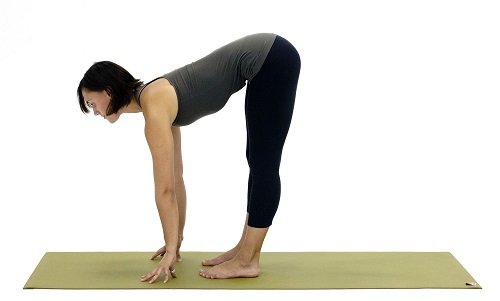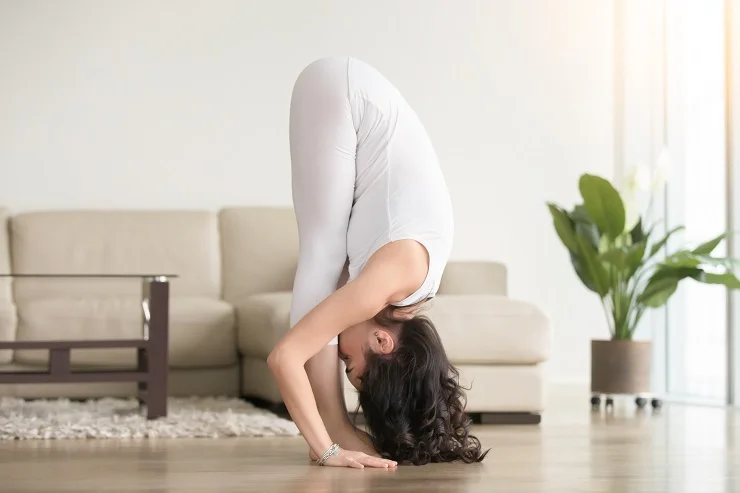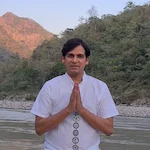Uttanasana, or Standing Forward Bend, is a foundational yoga pose that beautifully blends physical stretching with mental release. This simple yet powerful asana helps to lengthen the entire backside of the body—from heels to spine—while calming the mind and encouraging introspection.
The name comes from the Sanskrit words Ut (intense), Tan (to stretch), and Asana (posture). As an "intense forward stretch," it is a key component of the Sun Salutation and serves as a restful transition between standing poses. When performed with awareness, it becomes a moment of surrender and connection to your inner self.
What's in this Guide:
Key Benefits of Uttanasana
Physical Benefits
- Deeply stretches the hamstrings, calves, and hips.
- Strengthens the thighs and knees.
- Stimulates the liver and kidneys, improving digestion.
- Increases circulation to the brain.
Mental & Energetic Benefits
- Calms the mind and central nervous system, helping to relieve stress and mild anxiety.
- Activates the Ida Nadi (cooling energy channel).
- Encourages introspection, grounding, and a sense of letting go.
Step-by-Step Instructions
Follow these steps for safe and effective alignment in your Standing Forward Bend.
1. Start in Tadasana (Mountain Pose)

Stand tall at the top of your mat with your feet together or hip-width apart. Inhale, place your hands on your hips, and lengthen your spine.
2. Exhale and Hinge from the Hips

As you exhale, begin to fold forward, making sure the movement originates from your hip joints, not from rounding your waist. Keep your legs straight but do not lock your knees*.
3. Release and Hold

Let your hands rest on the floor, your shins, or blocks. Allow your head and neck to hang heavy, releasing all tension. With each inhale, feel your spine lengthen slightly. With each exhale, allow yourself to release deeper into the fold. Hold for 30 seconds to 1 minute.
Beginner’s Tip: If your hamstrings are tight, generously bend your knees. This protects your lower back and still allows you to receive the benefits of the pose.
4. Return to Standing Safely
To come up, bring your hands back to your hips. Engage your core, press your tailbone down, and inhale as you lift your torso with a flat back. Avoid rolling up through the spine, which can strain the lower back.
Watch the Pose in Action
Important Precautions
Always move gently and listen to your body. Please be cautious with this pose if you have:
- A current back injury, such as a herniated disc.
- Glaucoma or high blood pressure (avoid holding the pose for long periods).
- Pregnancy (practice with feet wide apart and avoid deep compression).

About the Author: Yogi Sandeep
Born in Rishikesh into a traditional family where the Vedic tradition has been a way of life for generations, Yogi Sandeep is the founder of Raj Yoga Rishikesh. He is an E-RYT 500 Teacher, holds a Master's degree in Yoga, and has over a decade of teaching experience.
Uttanasana FAQs
What if I can't touch the floor?
That is completely normal! Do not force it. Simply bend your knees enough so that your hands can comfortably rest on the floor or on a pair of yoga blocks. The goal is to lengthen the spine, not to touch the ground.
Is this pose good for lower back pain?
When done correctly (especially with bent knees), Uttanasana can help release tension in the lower back. However, if you have a serious injury like a herniated disc, you should avoid it or practice only under expert guidance.
How is this different from Paschimottanasana (Seated Forward Bend)?
Both poses stretch the hamstrings and spine. In Uttanasana (standing), gravity assists in deepening the fold and releasing the neck. In Paschimottanasana (seated), you actively use your muscles to draw yourself into the stretch, which can be more intense for some.
Build Your Foundation in Ashtanga
Surya Namaskara A is the heartbeat of Ashtanga Yoga. Learn to master it with authentic guidance in our in-person and online Yoga Teacher Training programs from the birthplace of yoga.
Explore Our Trainings →